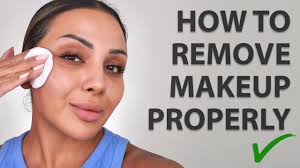**How to Remove Makeup: Expert Tips for a Truly Clean Face**
Even in today’s beauty world, properly removing makeup remains a crucial step in skin care. Despite our best efforts, many of us still leave traces of makeup behind. Here are some simple but effective tips to ensure your face is completely clean before bed.
### Tip 1: Let the Products Do Their Work
Instead of removing your makeup quickly, give the products time to dissolve your makeup. This allows your cleanser to dissolve primer, dirt, and oil so it can wipe them off more effectively. Try this:
1. Wet your face with warm water.
2. Use a makeup remover and make sure it’s eye-safe.
3. Leave on for about 2 minutes to remove the makeup.
4. Wipe the product off with a damp cloth or towel.
5. You can then continue with your normal skin care routine or double cleanse (more on that below).
### Tip 2: Avoid Makeup Wipes
While makeup wipes are convenient, they don’t clean thoroughly and can cause damage to your skin over time. Follow with a thorough cleanse to remove impurities from your pores. Makeup wipes can leave behind bacteria, dirt, and oil, which can lead to blemishes if not thoroughly cleansed.
### Tip 3: Choose the right cleansing product
Not all cleansers are created equal, and choosing the right one for your skin type can make a big difference. There are different textures, from balms and oils to gels and waters, each targeting specific skin needs. For example, dry skin will benefit from a moisturizing balm, while oily skin may prefer a gel formula.
### Tip 4: First step, avoid washing your face
Using a face cleanser to remove makeup is ineffective. It’s like trying to take a shower with your clothes on! Instead, use a makeup remover first, then gently wash your face. This double-cleansing technique ensures that makeup, dirt, and excess oil are thoroughly removed.
### Tip 5: Remove Mascara Properly
Mascara is notorious for being difficult to remove. How to avoid smudging and damaging your lashes:
1. Dip a cotton swab in makeup remover (micellar water works well).
2. Gently apply the product along your lashes to dissolve the mascara.
3. Using a cotton pad soaked in makeup remover, wipe upwards to remove the mascara.
If there is any mascara left, repeat the process carefully. Avoid pulling or tugging on your lashes.
### Tip 6: Don’t forget your neck and ears
If you wear makeup on your neck or ears, remember to cleanse those areas as well. Wipe these areas with a damp towel, then apply cleanser and wipe off with the same cloth, making sure every inch is makeup-free.
### Tip 7: Follow up with skin care afterwards
After cleansing, follow your usual skincare routine – moisturizer, serum, etc. Even if your skin feels refreshed after cleansing, it’s important to keep it moisturized to maintain your skin barrier. This helps prevent excess oil secretion if you have oily skin, or a tight feeling if you have dry skin.
By following these simple tips, you’ll ensure your face is makeup-free and ready for skin care, leaving your skin feeling clean, refreshed, and nourished.
DQH Can I use salicylic acid first and then vitamin C?
It’s easy to create a skincare routine, but knowing how to use it is another thing entirely. In most cases, if you’re not getting the desired skin results, it could be due to the layering of conflicting ingredients. So, is it possible that salicylic acid and vitamin C are such ingredients? Or are these active ingredients the duo that’s been missing from your skincare routine? If you want answers, stick around because today we are going to explain the benefits of salicylic acid and vitamin C and how they can be used in your daily life.
What are the benefits of salicylic acid for skin?
Salicylic acid is one of the most commonly used beta hydroxy acids and is favored by many people with oily, acne-prone skin. This acid is derived from willow bark, and unlike its water-soluble relatives (called alpha-hydroxy acids), salicylic acid is oil-soluble, which means it can penetrate deeper into the lower layers of the skin. Once it reaches the lower layers, it can help unclog pores of excess sebum, dirt, bacteria, debris, and impurities. This results in clearer skin tones and greater definition.
Not only does salicylic acid benefit the underlying layers, but the outer surface of the skin benefits as well. When applied to the skin, salicylic acid removes the buildup of dead skin cells. This is accomplished by breaking the bonds that hold dead cells to the surface. Over time, this can cause the complexion to look dull and prone to acne, blackheads, and other blemishes.
If you’d like to learn more about salicylic acid and how it can improve your skin, check out this dedicated blog post from a beauty insider.
What are the benefits of vitamin C for skin?
Vitamin C is considered one of the most powerful antioxidants, which means it is very effective at fighting free radicals and preventing them from causing further skin damage. Examples of free radicals include pollution, central heating, UV rays and harsh climate. They attack proteins, fats and cell membranes as soon as they come into contact with the skin, causing signs of premature aging such as fine lines and wrinkles as well as hyperpigmentation, flaky patches of skin and loss of elasticity.
Many people usually prefer to use vitamin C in their morning routine as this ingredient gives the complexion a radiant glow. You’ll also find that vitamin C can target areas of hyperpigmentation, plumping the skin and reducing the appearance of fine lines and wrinkles.
The thing about vitamin C is that there are a lot of outdated studies going back to the 1950s that describe vitamin C as an unstable skin component. Thanks to improvements in modern technology, this is no longer the case as all products now contain a stable form of vitamin C.
Visit The Beauty Insider to learn more about vitamin C. So please check out our blog post.
Can I use salicylic acid first and then vitamin C?
Yes, you absolutely can. In fact, it’s thought that using salicylic acid before using vitamin C ensures it penetrates faster and works faster.
This is an efficient way to utilize two power sources, and the reason has to do with pH. For example, the skin’s natural pH is about 4.7, making it slightly acidic. Salicylic acid and vitamin C are also both acidic, and you’ll find that vitamin C is absorbed quickly into the skin. Therefore, using salicylic acid beforehand can increase the acidity of the skin and allow vitamin C to penetrate into the skin faster.
While this is considered an effective way to combine two powerful ingredients, you need to be aware of your skin type and how it reacts to certain active ingredients. Even people with perfect, normal skin can experience skin sensitivity and irritation. Therefore, always consult a doctor or dermatologist before using any new products on your skin.
It’s also important to follow skin application rules. In this case, you need to use the product correctly to ensure you get the best results for your skin. If you’re not sure what I mean, the basic rule for skin is to start with the thinnest consistency and work your way up to the thickest consistency. This prevents a barrier from forming on the surface, preventing other active ingredients from penetrating the skin.
Can I use salicylic acid at night and vitamin C in the morning?
Yes, absolutely, this is considered the most effective way to get returns without any adverse side effects. This is because there is enough time between applications to ensure that the skin’s pH levels return to balance.
You’ll also find that Vitamin C is rich in antioxidants and is perfect for use in the morning to ensure your skin is protected and looking its healthiest. Due to the small size of salicylic acid molecules, it is an acid that is able to reach the deepest parts of the skin. While this is effective at keeping skin clear, it also increases the risk of irritation and photosensitivity. Therefore, many people prefer to use powerful BHAs in their evening routine without exposure to UV rays, pollution, or harsh weather.
Warning: If you avoid using sunscreen every day, none of these ingredients will do what your skin needs. The combination of chemical peels and powerful ingredients increases the risk of further damage to the skin’s surface. Use SPF 50 every day to keep your skin protected and your lipid barrier healthy, even on cloudy days, keeping your skin in top condition.



